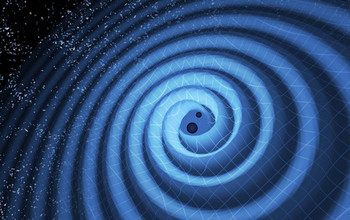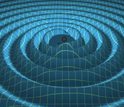News Release 16-072
Gravitational waves detected from second pair of colliding black holes
LIGO Scientific Collaboration and Virgo collaboration identify second gravitational wave event using data from Advanced LIGO detectors

The black holes were eight and 14 times the mass of the sun, until they merged.
June 15, 2016
This material is available primarily for archival purposes. Telephone numbers or other contact information may be out of date; please see current contact information at media contacts.
On Dec. 26, 2015 at 03:38:53 UTC, scientists observed gravitational waves -- ripples in the fabric of spacetime -- for the second time.
The gravitational waves were detected by both of the twin Laser Interferometer Gravitational-Wave Observatory (LIGO) detectors, located in Livingston, Louisiana, and Hanford, Washington.
The LIGO Observatories are funded by the National Science Foundation (NSF), and were conceived, built and are operated by Caltech and the Massachusetts Institute of Technology (MIT). The discovery, accepted for publication in the journal Physical Review Letters, was made by the LIGO Scientific Collaboration (which includes the the German/British collaboration for the detection of gravitational waves and the Australian Consortium for Interferometric Gravitational Astronomy) and the Virgo Collaboration, using data from the two LIGO detectors.
"With the advent of Advanced LIGO, we anticipated researchers would eventually succeed at detecting unexpected phenomena, but these two detections thus far have surpassed our expectations," said NSF Director France Córdova. "NSF's 40-year investment in this foundational research is already yielding new information about the nature of the dark universe."
Gravitational waves carry information about their origins and about the nature of gravity that cannot otherwise be obtained, and physicists have concluded that these gravitational waves were produced during the final moments of the merger of two black holes -- eight and 14 times the mass of the sun -- to produce a single, more massive spinning black hole that is 21 times the mass of the sun.
"It is very significant that these black holes were much less massive than those observed in the first detection," said Gabriela Gonzalez, LIGO Scientific Collaboration (LSC) spokesperson and professor of physics and astronomy at Louisiana State University. "Because of their lighter masses compared to the first detection, they spent more time -- about one second -- in the sensitive band of the detectors. It is a promising start to mapping the populations of black holes in our universe."
During the merger, which occurred approximately 1.4 billion years ago, a quantity of energy roughly equivalent to the mass of the sun was converted into gravitational waves. The detected signal comes from the last 27 orbits of the black holes before their merger. Based on the arrival time of the signals -- with the Livingston detector measuring the waves 1.1 milliseconds before the Hanford detector -- the position of the source in the sky can be roughly determined.
"In the near future, Virgo, the European interferometer, will join a growing network of gravitational wave detectors, which work together with ground-based telescopes that follow-up on the signals," noted Fulvio Ricci, the Virgo Collaboration spokesperson, INFN & Sapienza University of Rome. "The three interferometers together will permit a far better localization in the sky of the signals."
The first detection of gravitational waves, announced on Feb. 11, was a milestone in physics and astronomy; it confirmed a major prediction of Albert Einstein's 1915 general theory of relativity, and marked the beginning of the new field of gravitational-wave astronomy.
The second discovery "has truly put the 'o' for observatory in LIGO," said Caltech's Albert Lazzarini, deputy director of the LIGO Laboratory. "With detections of two strong events in the four months of our first observing run, we can begin to make predictions about how often we might be hearing gravitational waves in the future. LIGO is bringing us a new way to observe some of the darkest yet most energetic events in our universe."
MIT's David Shoemaker, who led the Advanced LIGO detector construction program, noted that "We are starting to get a glimpse of the kind of new astrophysical information that can only come from gravitational wave detectors."
Both discoveries were made possible by the enhanced capabilities of Advanced LIGO, a major upgrade that increases the sensitivity of the instruments compared to the first generation LIGO detectors, enabling a large increase in the volume of the universe probed.
Advanced LIGO's next data-taking run will begin this fall. By then, researchers expect further improvements in detector sensitivity will allow LIGO to reach as much as 1.5 to 2 times more of the volume of the universe. The Virgo detector is expected to join in the latter half of the upcoming observing run.
LIGO research is carried out by the LIGO Scientific Collaboration (LSC), a group of more than 1,000 scientists from universities around the United States and in 14 other countries. More than 90 universities and research institutes in the LSC develop detector technology and analyze data; approximately 250 students are strong contributing members of the collaboration. The LSC detector network includes the LIGO interferometers and the GEO600 detector.
Virgo research is carried out by the Virgo Collaboration, consisting of more than 250 physicists and engineers belonging to 19 different European research groups: six from Centre National de la Recherche Scientifique (CNRS) in France; eight from the Istituto Nazionale di Fisica Nucleare (INFN) in Italy; two in The Netherlands with Nikhef; the MTA Wigner RCP in Hungary; the POLGRAW group in Poland and the European Gravitational Observatory (EGO), the laboratory hosting the Virgo detector near Pisa in Italy.
NSF leads in financial support for Advanced LIGO. Funding organizations in Germany (Max Planck Society), the U.K. (Science and Technology Facilities Council, STFC) and Australia (Australian Research Council) also have made significant commitments to the project.
Several of the key technologies that made Advanced LIGO so much more sensitive have been developed and tested by the German UK GEO collaboration. Significant computer resources have been contributed by the AEI Hannover Atlas Cluster, the LIGO Laboratory, Syracuse University, the ARCCA cluster at Cardiff University, the University of Wisconsin-Milwaukee, and the Open Science Grid. Several universities designed, built and tested key components and techniques for Advanced LIGO: The Australian National University, the University of Adelaide, the University of Western Australia, the University of Florida, Stanford University, Columbia University in the City of New York, and Louisiana State University. The GEO team includes scientists at the Max Planck Institute for Gravitational Physics (Albert Einstein Institute, AEI), Leibniz Universität Hannover, along with partners at the University of Glasgow, Cardiff University, the University of Birmingham, other universities in the United Kingdom and Germany, and the University of the Balearic Islands in Spain.
-NSF-
-
View Video
An artist's animation shows the merger and the gravitational waves that ripple outward.
Credit and Larger Version -
View Video
The best-fit models of LIGO's gravitational-wave signals are converted into sounds.
Credit and Larger Version
Media Contacts
Ivy F. Kupec, NSF, (703) 292-8796, email: ikupec@nsf.gov
Mimi LaValle, LIGO Scientific Collaboration, (225) 439-5633, email: mlavall@lsu.edu
Séverine Perus, EGO–European Gravitational Observatory, email: severine.perus@ego-gw.it
Kimberly Allen, Massachusetts Institute of Technology(MIT), (617) 253-2702, email: allenkc@mit.edu
Whitney Clavin, California Institute of Technology (Caltech), (626) 390-9601, email: wclavin@caltech.edu
Program Contacts
Pedro Marronetti, NSF, (703) 292-7372, email: pmarrone@nsf.gov
The U.S. National Science Foundation propels the nation forward by advancing fundamental research in all fields of science and engineering. NSF supports research and people by providing facilities, instruments and funding to support their ingenuity and sustain the U.S. as a global leader in research and innovation. With a fiscal year 2023 budget of $9.5 billion, NSF funds reach all 50 states through grants to nearly 2,000 colleges, universities and institutions. Each year, NSF receives more than 40,000 competitive proposals and makes about 11,000 new awards. Those awards include support for cooperative research with industry, Arctic and Antarctic research and operations, and U.S. participation in international scientific efforts.
Connect with us online
NSF website: nsf.gov
NSF News: nsf.gov/news
For News Media: nsf.gov/news/newsroom
Statistics: nsf.gov/statistics/
Awards database: nsf.gov/awardsearch/
Follow us on social
Twitter: twitter.com/NSF
Facebook: facebook.com/US.NSF
Instagram: instagram.com/nsfgov




